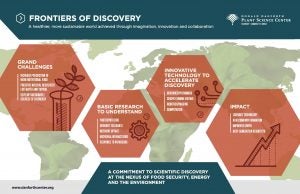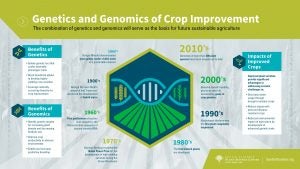Deep in the darkest dirt of America’s Midwest, Wall Street capital waters the seeds of Silicon Valley technology. And the gadgets and systems once considered storylines for science-fiction films are coming up by the wagon-load as a result.
Sam Fiorello, Chief Operating Officer of the Donald Danforth Plant Science Center and President of its associated Bio Research & Development Growth (BRDG) Park, said investors and investigators alike are finding great success in the world-class research institute in St. Louis.
“People here get it,” he said, explaining how well the diverse set of agronomics specialists gel together, far removed from either coast. Centrally located St. Louis lies amid the richest farm soils in the world, surrounded by fields associated with the nearby headquartered National Corn Growers Association and Monsanto. Multiple generations of agricultural heritage also fertilize the Mississippi River region top to bottom, yielding a tremendous amount of infrastructure and support from the biggest farmers in America. “Things like that really create a special presence.”
In October, the Donald Danforth Plant Science Center announced yet another big win for ag-science with a five-year $16 million grant from the U.S. Department of Energy (DOE) building on earlier work using the model grass, green foxtail (Setaria viridis). Investigators hope to identify new genes and pathways that contribute to photosynthesis and enhance water-use efficiency to help in the emerging field of synthetic biology for development of elite energy sorghum varieties to be produced in marginal environments.
“Sorghum is an attractive bioenergy feedstock supported by well-developed breeding and seeding industry. This project will leverage recent investments by DOE to further accelerate sorghum feedstock enhancements, develop new gene editing and transformation technologies and conduct a whole genome association study to identify genes to improve sorghum productivity,” stated co-principal investigator Todd Mockler, Ph.D., in a media release announcing the work.
Fiorello explained that sorghum is of particular interest for potential use in both bio-fuels and as a biomass. Well-suited for marginal ground that doesn’t handle food crops well, it’s been well received in the food-versus-fuel debate.

In terms of development, the entire field of bio-fuels is where computers were about 25 years ago, Fiorello said, quickly noting that that area is just one of many being advanced at the speed of research. Specialists in plant physiology, genetics, molecular biology, informatics, computational biology and genetic engineering from more than 26 universities and nations around the globe are collaborating at the Donald Danforth Plant Science Center, which itself has grown by leaps and bounds since its founding in 1998. Today, the 235-employee research and industrial park hosts 175 scientists, 20 of whom serve as principal investigators, and in 2015 produced 115 articles in peer-reviewed scientific publications. The 2015 operating budget of $27 million came largely from competitive research grants from organizations including the Bill & Melinda Gates Foundation and the U.S. National Science Foundation. The next big expansion project, Fiorello said, is a 79,000-square foot William H. Danforth Wing which will host an additional 100 scientists.
But it’s more than bio-fuels and bio-mass being developed these days, as researchers work to understand and re-design plant genetics, developing an entirely new generation of computer software and hardware along the way. Everything from drone technology to new statistical analysis programs is being created, often with the same investors who back such corporate giants as Google and Facebook. While agriculture itself is several millennia old, it’s no secret that the tools used to manage it are changing every day.
Why the Midwest?
Matthew Crisp, president and CEO of Benson Hill Biosystems, agreed the rural zones of Midwestern America are proving fertile ground for a unique blend of science and technology. A start-up now in its second series of funding, BensonHill Biosystems recently launched its novel genome editing CRISPR 3.0 technology. The company’s computational platform CropOS combines powerful data analytics and machine learning to allow companies of any size to access the most advanced tools in seed innovation without major infrastructure costs. The CRISPR 3.0 portfolio of nucleases demonstrate a shorter length than many other widely-used nucleases, Crisp explained, noting this affords easier delivery.
“Genome editing holds immense potential to lower product development costs and level the playing field beyond those few companies with the largest R&D budgets,” he stated. “CRISPR 3.0 expands the portfolio of genome editing capabilities we are building for our partners to leverage the natural genetic diversity of plants and develop more nutrient-dense crops, improve crop productivity, and use natural resources more efficiently.”
Crisp said emerging companies look for three things when choosing a location: Infrastructure, talent, and money.
“St. Louis was really the only place that offered up those things for BensonHill,” he said, noting the company was actually born and incorporated in North Carolina but has grown operations into the Donald Danforth Plant Science Center, next to a number of other start-ups.

The Midwest affords researchers in the field of plant genetics the opportunity to work in both “dry-wear” and “wet-wear,” he said, explaining the former involves the computer programing systems while the latter is the actual seed-work in greenhouses and fields. The Donald Danforth Plant Science Center’s 50,000-square feet of greenhouse space is a big plus, as well as the giant swaths of farmland throughout the region. “We’re in 13 different field sites for corn in the Midwest.”
Top universities with strong agriculture programs also dot the landscape, from Washington University in St. Louis to the University of Illinois-Champaign and University of Missouri at Columbia. And the sheer affordability of office space and other living needs relative to the coasts makes the heartland attractive, he said, noting many of his companies employees are transplants quite happy with the move.
And venture capital funds are streaming in from both coasts, as well as from within the deep wellspring of wealth located in the Midwest itself. Michael Helmstetter, CEO of TechAccel LLC, with locations in both Kansas and Missouri, connects investors with scientists and researchers working on agriculture-related technology. Noting the unbelievable amount of intellectual property sitting in university research laboratories with no portal to market, his firm specializes in helping entrepreneurs and researchers bring technology to life. And the Midwest, he said, is really where it’s at and needs to quit trying to be the West Coast and simply be itself.
“This is where it’s at. Multi-generational farmers and good land and good water,” he said, pointing out the number of top veterinary science schools and other research programs throughout the heartland. “I think one of the challenges for the Midwest is that we’re humble and don’t beat our chests enough.”
That said, the investors of Silicon Valley are taking note nonetheless. The whole move toward innovative plant genetics is related to the same Artificial Intelligence computer technology and genomic sequencing software used in humans, he said.
“That’s really where this world is,” he said, observing how much cheaper it is today to study any of the gene-related fields due the same technology being used in multiple fields. Even a few years ago, the idea of sequencing the genes and proteins involved in photosynthesis was too costly to consider. But all that is changing as tech companies offer individuals a blueprint of their own genome for a hundred dollars. Matching up bioinformatics with plant science makes sense for all involved, and there’s no better place than in an area where potential employees have a solid understanding of the real dirt involved. Meanwhile, the entire Midwest offers such a different lifestyle than either coast, it remains an incredible attractive place to live for the best and brightest of science.
From the investor side, Helmstetter predicts even more growth in the direction of gene editing in plants, as companies seek to utilize them as veritable energy factories.
“We’re very interested in the concept of the plant being a manufacturing machine,” he said, noting the number of innovations coming by way of plant-derived vaccines and medicines.
More yields coming
Fiorello said the annual Ag Innovation Showcase jointly sponsored by the BRDG Park and Donald Danforth Plant Science Center has grown from a small collaborative born in 2009 to a flagship event.
“The secret is out,” he said, pointing out nearly $500 million has been raised post-event by presenting companies seeking venture capital. Some 97 percent of participating companies have obtained new investment leads, with six acquisitions and 130 industry technologies vetted.
The BRDG Park associated with the center is home to 10 enterprises, only three of which are from St. Louis. The 10 entities employ about 200 people and hail from all over the U.S., Germany, Israel and India. From research institutes to venture capitalists and the companies both support, the Midwest is drawing from the best and brightest of Earth. And the work done here is crucial considering the world population is expected to hit 9.7 billion humans by 2050, with close to a quarter of today’s people facing malnutrition. More and more each day it’s becoming clearer that American farmers feed the world, and the Midwest is where the action is.



